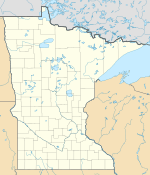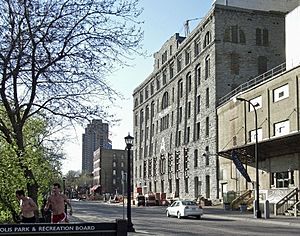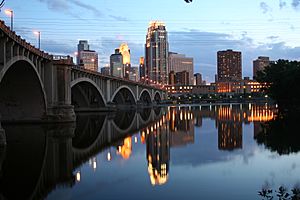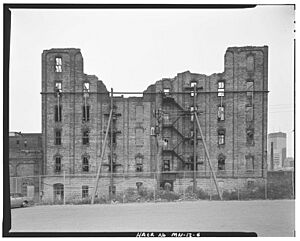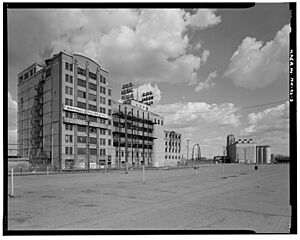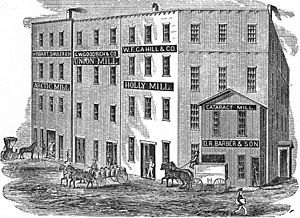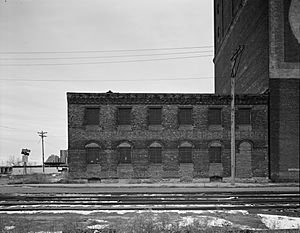St. Anthony Falls Historic District facts for kids
Quick facts for kids |
|
|
St. Anthony Falls Historic District
|
|
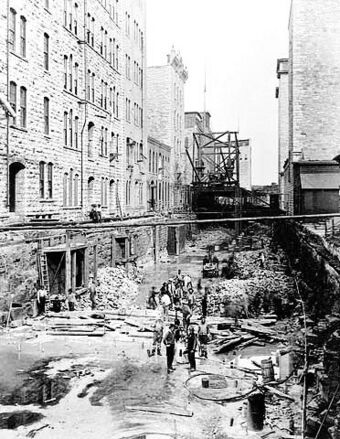
Power Canal being made deeper with concentrated mills on both sides 1885 (Minnesota Historical Society)
|
|
| Location | Minneapolis, Minnesota |
|---|---|
| Engineer | Significant William de la Barre |
| NRHP reference No. | 71000438 |
| Added to NRHP | March 11, 1971 Addition 1991 |
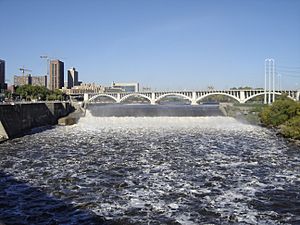
The Saint Anthony Falls Historic District in Minneapolis, Minnesota, United States is a special area. It's listed on the National Register of Historic Places. This means its buildings and sites are important to history. The "period of significance" for the district was from 1858 to 1941. This area's old underground remains are considered some of Minnesota's most endangered historic sites.
Contents
Protecting History: The St. Anthony Falls Historic District
Long ago, people thought new buildings were always better. This idea was called "City Beautiful." It meant tearing down old places to build grand new ones. For example, the Metropolitan Building in downtown Minneapolis was torn down in 1961. This made people start thinking about saving historic buildings. But at first, they didn't think about the old industrial areas around the falls.
By the 1960s, many flour mills on the west side of the river were gone. Waterpower was no longer used after 1960. Only a few mills still worked, and the last one, Washburn A mill, closed around 1965. In 1969, only four old flour mills were still standing. Many historic buildings were empty or used for storage.
In 1966, a law called the National Historic Preservation Act of 1966 was created. It helped protect historic places and started the National Register of Historic Places. Because of this, Minneapolis created the St. Anthony Falls Historic District. It was added to the National Register in 1971. The first list included 21 existing buildings. Minneapolis realized that the riverfront and its history could attract people.
In 1980, the Minneapolis Park Board wanted to extend a parkway through the mill district. This led to a special review. The review found many old remains underground in the mill area. These remains were especially under gravel piles near the power canal. More remains were also found between the falls and Plymouth Avenue.
A lot of public money has been spent to improve the Historic District. This includes public places like the Mill City Museum and Mill Ruins Park. It also helped private companies fix up historic buildings.
People learned a lot more about the Historic District over time. So, in 1991, the National Register listing was updated. It added much more information and over four times as many historic sites. Many of these new additions were archaeological remains and houses on Nicollet Island.
Historic Buildings and Sites Still Standing Today

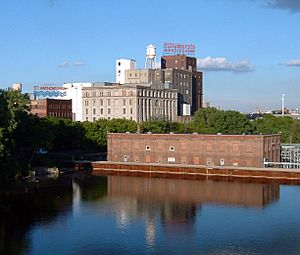

The St. Anthony Falls Waterpower Area
People have used the waterpower from St. Anthony Falls for a long time. The first sawmill was built in 1821, and a grist mill (for grinding grain) in 1823. These were built by Ft. Snelling. Once the area was open for settlement, people quickly claimed land to use the waterpower. The falls became a major center for sawmills. Then, from 1880 to 1930, it had the largest flour production in the US.
In 1881, one of the first power plants in the US was built here. It used water to make electricity for streetlights. Two other big hydroelectric plants were built in 1894/1911 and 1908. Another plant was built in 1895 just downstream. One of these plants is still working today! Many other businesses also used power from the falls. The city of Minneapolis grew around these industries. A big part of the Historic District is what's left of these old industries, including things found underground.
Here are some important places still standing in this area:
- Crown Roller Mill/Consolidated "A" mill: This mill made a lot of flour. It was one of the first big mills to use new roller milling technology. Production stopped in 1953. A big fire in 1983 destroyed much of it. But it was rebuilt inside its old walls and is now an office building.
- Falls of St. Anthony: The actual waterfall itself.
- Falls of St. Anthony Apron: This is a concrete spillway that protects the falls. It was built in 1952 to replace an older wooden one. It stops the falls from eroding further upstream.
- Falls of St. Anthony Dike: A concrete wall built under the river to fix problems from the Eastman tunnel disaster.
- Falls of St. Anthony Dam (Horseshoe/upper dam): An important dam built in 1858.
- Hennepin Island Hydroelectric Plant: A power plant built in 1908 on Hennepin Island.
- Main Street Hydroelectric Station: Another power plant built in 1911.
- North Star Woolen Mill: An old mill building, now called North Star Lofts.
- Northwestern Consolidated Milling Company Elevator A (Ceresota Elevator): A large grain elevator, now Millers Landing Senior Living.
- Pillsbury "A" Mill Complex: A very famous mill complex. The main A-mill and other buildings were turned into artist lofts in 2015.
- Pillsbury Industrial Equipment/Pillsbury Machine Shop: Now used as an event venue.
- Pracna Building: Built in 1890 as a saloon. In 1973, it became "Pracna on Main," one of the first businesses to help bring life back to the east bank of the river.
- St. Anthony Falls Hydraulic Laboratory: A research lab on Hennepin Island built in 1938.
- St. Anthony Falls Water Power Co. Canal/Pillsbury Canal: This was actually a tunnel that brought water to the Pillsbury "A" mill's turbines. It's now part of the A-mill artist lofts redevelopment.
- St. Anthony Falls Water Power Co. Tailrace/Chute Tunnel: A tunnel under Main Street SE. Work on it stopped when it hit a hidden cave called Chute's Cave. The cave and tunnels still exist and are home to bats.
- Standard Flour Mill/Northwestern Consolidated "F" mill: Now the Whitney Lofts.
- Stone Arch Bridge: A beautiful stone bridge built in 1883.
- Upton Block/Union Iron Works: Now the Aster Cafe.
- Washburn, Crosby & Company "A" Flour Mill (Washburn "A" Mill Complex): Many buildings in this complex became the Mill City Museum. It also includes large grain elevators with "Gold Medal Flour" signs.
Nicollet Island Residential Area
The top part of Nicollet Island has many historic houses. They show different building styles and were home to middle and working-class families. There were plans to tear down these houses for a park. But the people living there fought to save their homes, and they won in 1983!
Here are some of the historic houses on Nicollet Island:
- Adams-Barquist House
- Andrew and Ole Loberg House (two locations)
- Backe-Barquist House
- Baker-Leber House
- Barquist-Holmberg House
- Brookins, George, W., House
- Griswold, Franklin G., House (two locations)
- Grove St. Flats (Eastman Flats)
- John Mayell House
- Meader-Farnham House
- Murphy, Edward, House
- O'Brien-Meyer House
- Pease, R.M.S, House
- Pye, James, House
- William D. Burnett Tenement
- Woodward Flat Duplex
- Woodward Flat Fourplex
Other Important Historic Places Still Standing
- Ard Godfrey House: This house, built in 1848, is the oldest wooden house still standing in the Twin Cities. Ard Godfrey was the first millwright to build a commercial sawmill at the falls. The house has been moved four times to protect it and is now a museum.
- Island Sash and Door Factory: Now the Nicollet Island Inn.
- Lucy Wilder Morris Park: A park near the river.
- Minneapolis Post Office - Main Station: A large post office building built in 1932.
- Old Main Street (Main St. SE): A historic street.
- Our Lady of Lourdes Catholic Church: A church built in 1858.
- Pillsbury Public Library: A library built in 1904.
- Third Avenue Bridge: A bridge built in 1917.
Historic Sites Now Gone (But with Remains Underground)
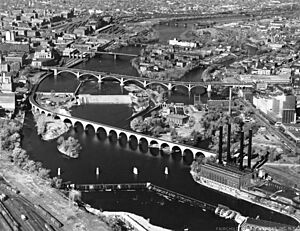
Sites Linked to the West Bank Power Canal
The St. Anthony Falls area was the top flour milling center in the US from 1880 to 1930. After that, many mills on the west bank were torn down. By the 1960s, most of the remaining mills were demolished or left empty. When mills were torn down, their foundations, tunnels, and sometimes even turbines were left underground. Because the riverfront was abandoned, these remains were not destroyed by new buildings. Many of these sites are now part of the Mill Ruins Park.
Some of these important sites include:
- Alaska Flour Mill/Pillsbury "B" Flour Mill
- Anchor Flour Mill
- Arctic Flour Mill
- Cataract Flour Mill
- Clapp Woolen Mill/Empire Mill/Pillsbury "B" Elevator
- Columbia Flour Mill
- First City Waterworks/Holly Flour Mill
- Galaxy Flour Mill
- Minneapolis Mill Co. Gatehouse & Power Canal
- Northwestern Flour Mill
- Palisade Flour Mill
- People's Flour Mill
- Pettit Mill
- Russell Mill/Dakota Mill/King Midas Flour Mill
- Union Flour Mill
- Washburn "B" Flour Mill Complex
- Washburn "C" Flour Mill Complex
- Washburn-Crosby Company Elevator No. 2: These were large grain elevators that fed the mills. They were torn down in 1998, and now Gold Medal Park is on the site.
- Zenith Flour Mill
Other Razed Historic Sites
- Gateway Residential Area: This was a neighborhood near the river. People had to move in 1883 because of railroad expansion. The Stone Arch Bridge brought trains to a new station nearby. There are still archaeological remains of this area.
- Hennepin Avenue Bridge Archaeological Site: This site has remains of the first permanent bridge across the Mississippi River (1854) and a later bridge (1876).
- Phoenix Flour Mill/Pillsbury Rye Mill
- Pillsbury "A" Steam Power Plant: Mills often used steam power when water flow was low. This plant helped the Pillsbury A mill.
- West Side Power Plant
Other Important Historic Properties
These places are in the St. Anthony Falls Historic District but are not listed as "contributing resources." This means they are important but don't count towards the district's main historical value.
- Brown Ryan Livery Stable: This building was moved in 1981 to save it. It's now part of the Riverplace complex.
- Fuji Ya Restaurant: This restaurant opened in 1968 on the foundations of old mills. It was an early business that helped bring life back to the west bank. The building was torn down, and a new [Water Works Pavilion and Restaurant] opened on the same spot in 2021.
- Merriam Street Bridge: This bridge was once part of a larger bridge built in 1887. One section was moved downriver to become the Merriam Street Bridge.
- Minneapolis Boiler Works: This building housed many metalworking companies. It was torn down in 1985 for new development.
- John H Stevens House: Built in 1850, this is the first permanent house in Minneapolis. It has been moved four times and is now in Minnehaha Park.
Images for kids
-
Panoramic photo from the new Water Power Park, visible from this vantage: the lower portion of Saint Anthony Falls; the concrete wall on the far side of the falls is part of the locks to allow ships to pass the waterfall; to the left is the Stone Arch Bridge, above it is the Guthrie Theater; to the right of the Guthrie are the white silos and reconstructed shell of the former Washburn "A" Mill, now the Mill City Museum; to the right of the museum are a series of redeveloped flour and grain mills making up a significant portion of the city's Mills District.
See also
- Mill Ruins Park
- Northwestern Consolidated Milling Company
- St. Anthony Falls Hydroelectric Development
- Saint Anthony Falls - Industry
- Whitney Mill Quarter Redevelopment


